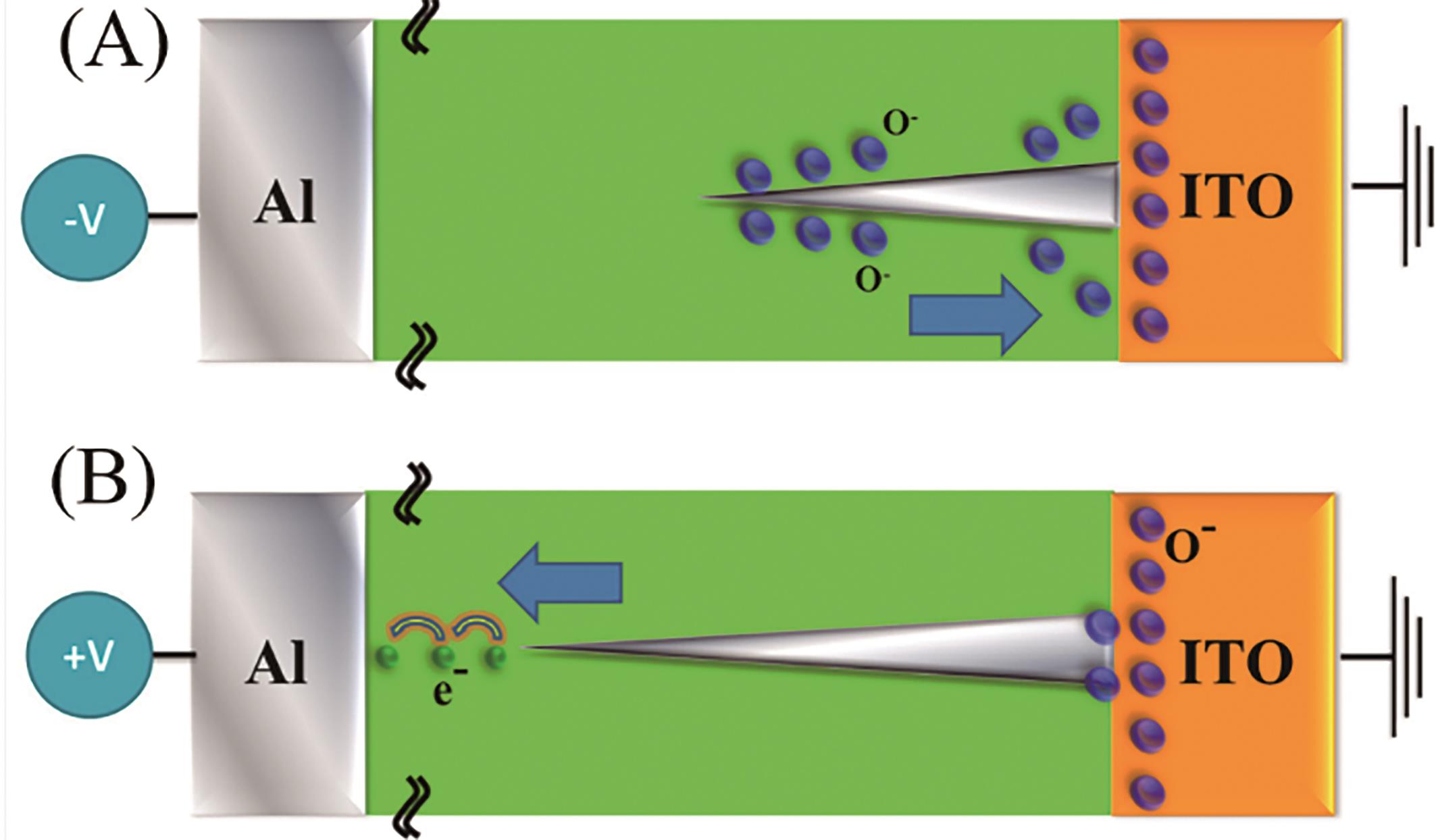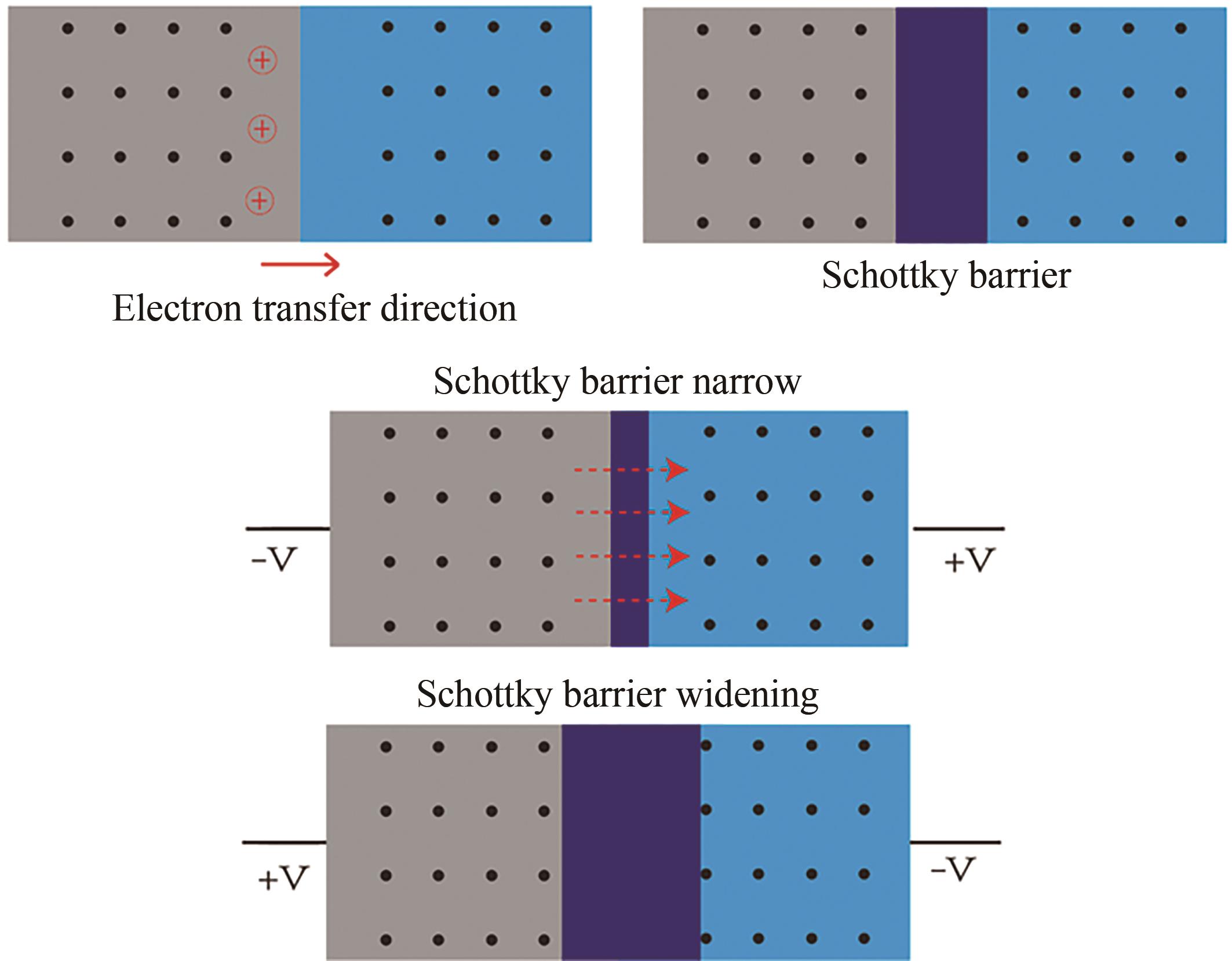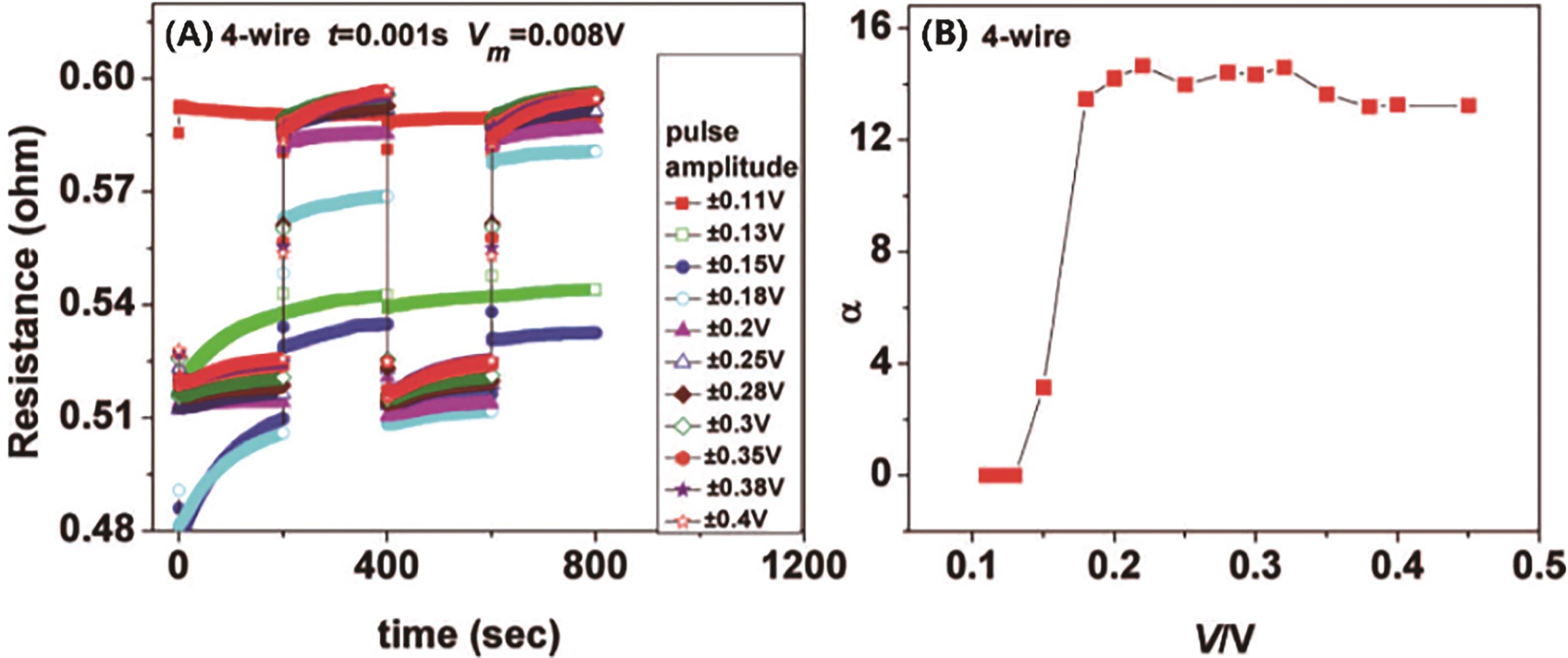
Chinese Journal of Applied Chemistry ›› 2023, Vol. 40 ›› Issue (11): 1457-1474.DOI: 10.19894/j.issn.1000-0518.230106
Research Progress on Rare Earth-Based Oxide Memristor
Wang SU, Quan-Li HU( ), Jing-Hai LIU(
), Jing-Hai LIU( )
)
- Nano Innovation Institute,College of Chemistry and Materials Science,Inner Mongolia Minzu University,Inner Mongolia Energineerin Research Center of Lithium-Sulfur Battery Energy Storafe,Tongliao 028000,China
-
Received:2023-04-14Accepted:2023-08-18Published:2023-11-01Online:2023-12-01 -
Contact:Quan-Li HU,Jing-Hai LIU -
About author:jhliu2008@sinano.ac.cn
huquanly@imun.edu.cn
-
Supported by:the National Natural Science Foundation of China(22261043);Inner Mongolia Autonomous Region Grassland Talent Project Young Leading Talents(KYCYYC23001);Inner Mongolia Natural Science Foundation(2022QN02016);the Research Project of Colleges and Universities in Inner Mongolia Autonomous Region(NJZZ22461);the Doctoral Scientific Research Foundation of Inner Mongolia Minzu University(BS456)
CLC Number:
Cite this article
Wang SU, Quan-Li HU, Jing-Hai LIU. Research Progress on Rare Earth-Based Oxide Memristor[J]. Chinese Journal of Applied Chemistry, 2023, 40(11): 1457-1474.
share this article
Add to citation manager EndNote|Ris|BibTeX
URL: http://yyhx.ciac.jl.cn/EN/10.19894/j.issn.1000-0518.230106
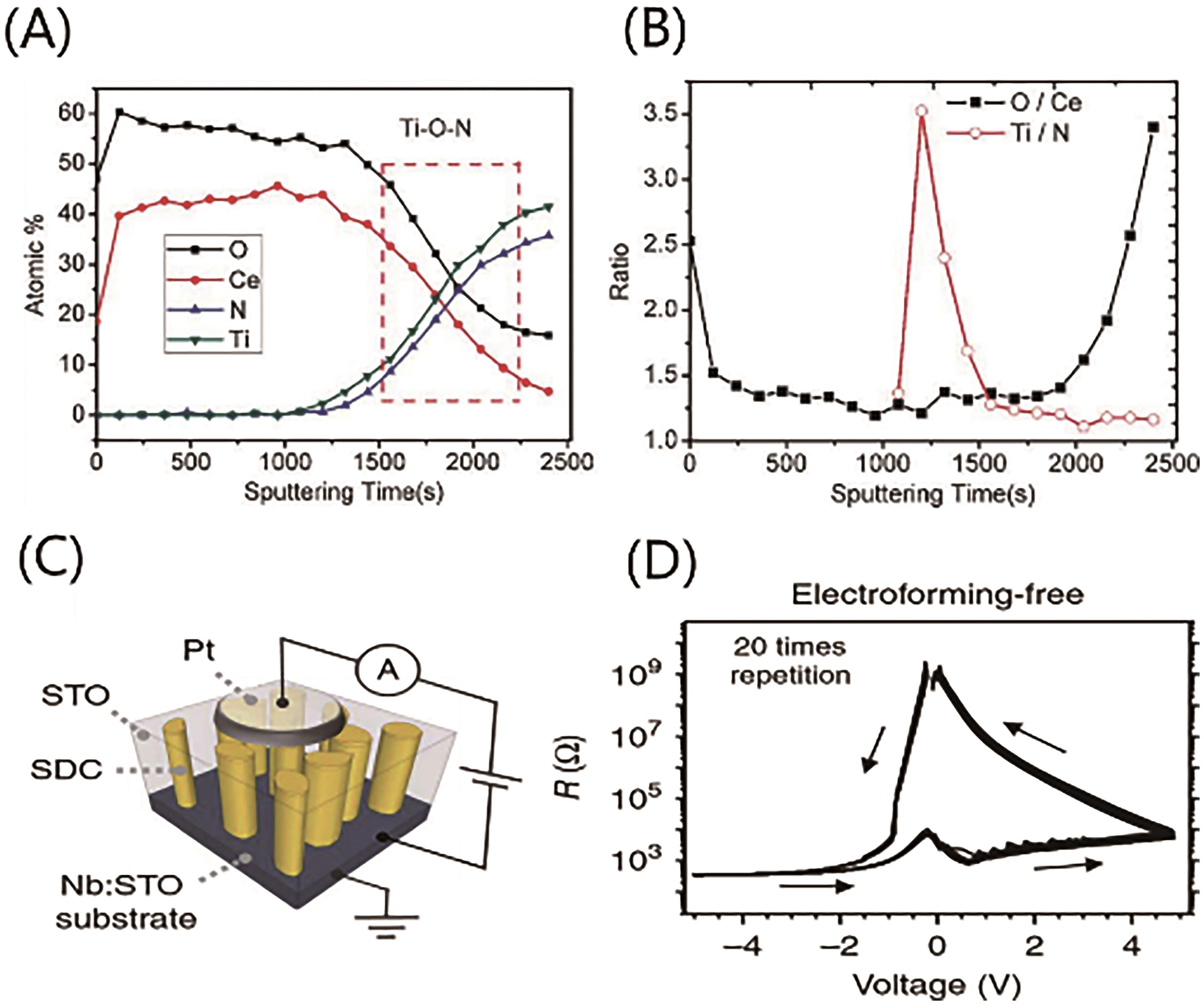
Fig.5 (A) The depth profiles of Ce, Ti, O and N[16]; (B) The atomic ratios of O/Ce and Ti/N for CeO x /TiN stacked film[16];(C) Schematic configuration of SDC∶SrTiO3 (STO) vertical heteroepitaxial nanocomposite(VHN) device[31]; (D) Electroforming-free R-V hysteresis loops in SDC∶STO VHN device[31]
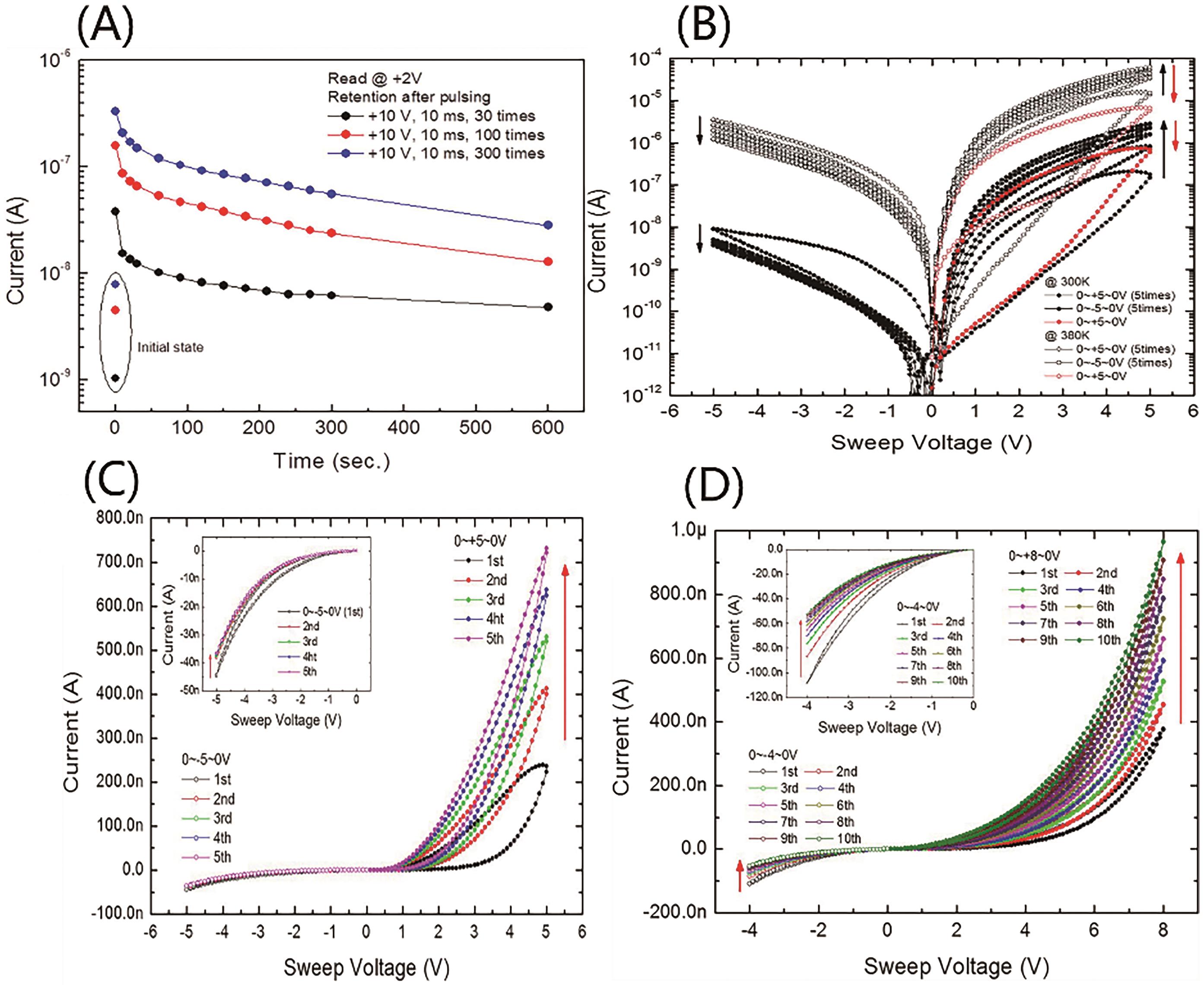
Fig.6 (A) Retention for long-term memory stability after repeated pulsing +10 V for 10 ms[32]; (B) I-V curves as repeating voltage sweep of 0→+5→0 V five times first, and 0→-5→0 V five times second, and then finally 0→+5→0 V once at the temperature of 300 and 380 K[33]; I-V curves of (C) Pt/CeO2/Pt reference device during five repeated voltage sweeps of 0→+5→0 V and five successive sweeps of 0→-?5→0 V and (D) Pt/ITO/CeO2/Pt during ten repeated voltage sweeps of 0→+8→0 V and ten successive sweeps of 0→-4→0 V[34]
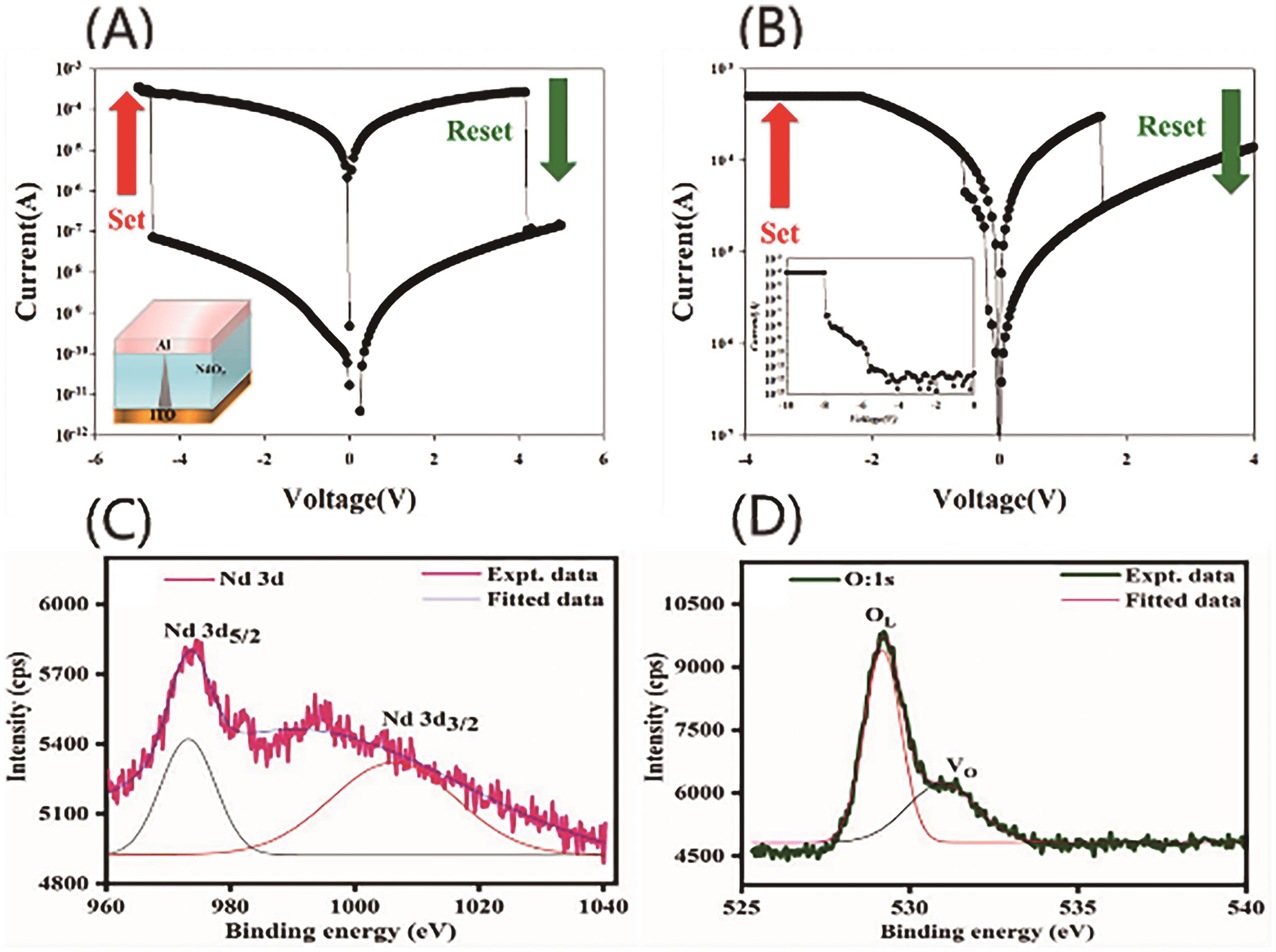
Fig.7 Bipolar switching curves of the neodymium oxide thin films for (A) 40% and (B) 60% (volume fraction) oxygen concentration parameters[18]; XPS (C) Nd3d states and (D) O1s states[38]
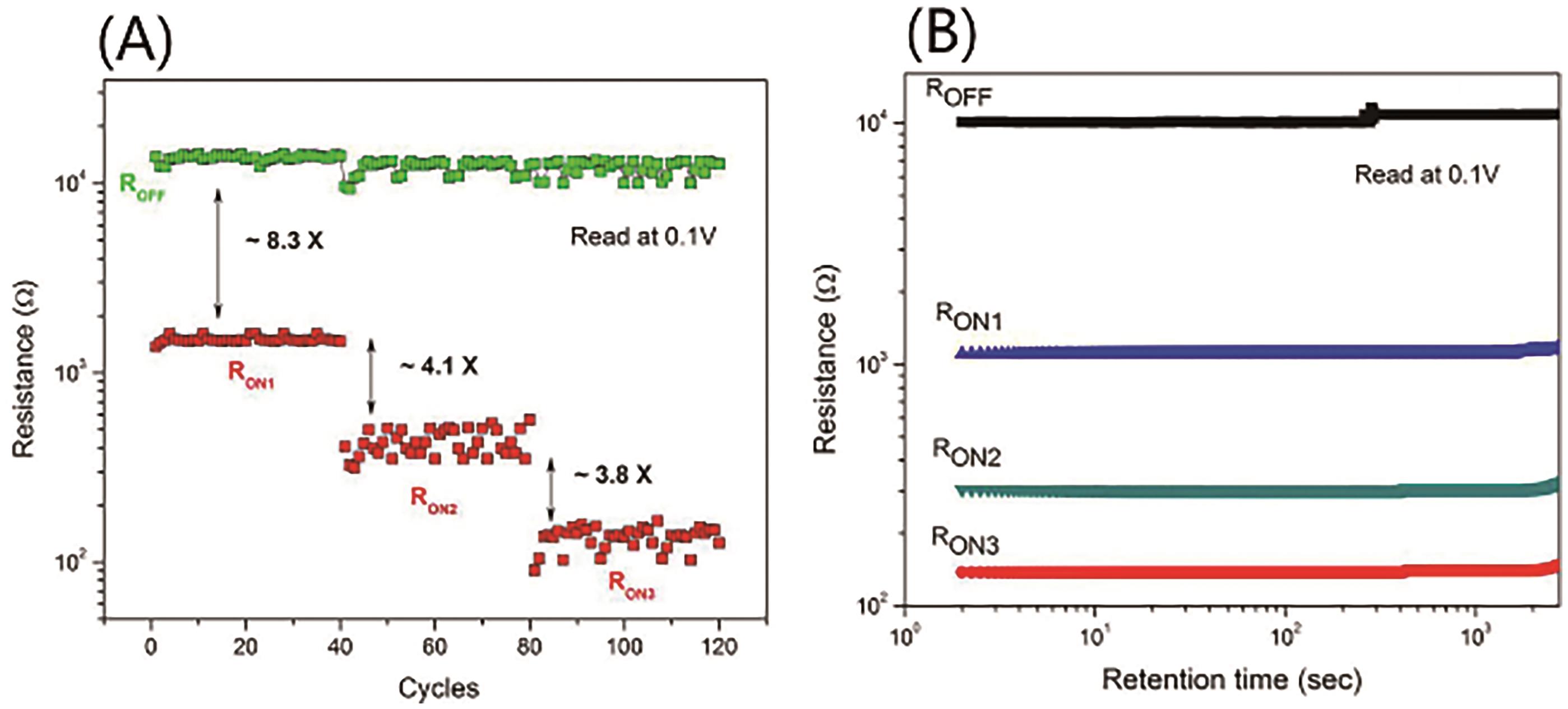
Fig.8 (A) The endurance of the Pt/SGO/Pt ReRAM device over 120 cycles with different ICC; (B) The retention characteristic of different resistance states for the device[40]
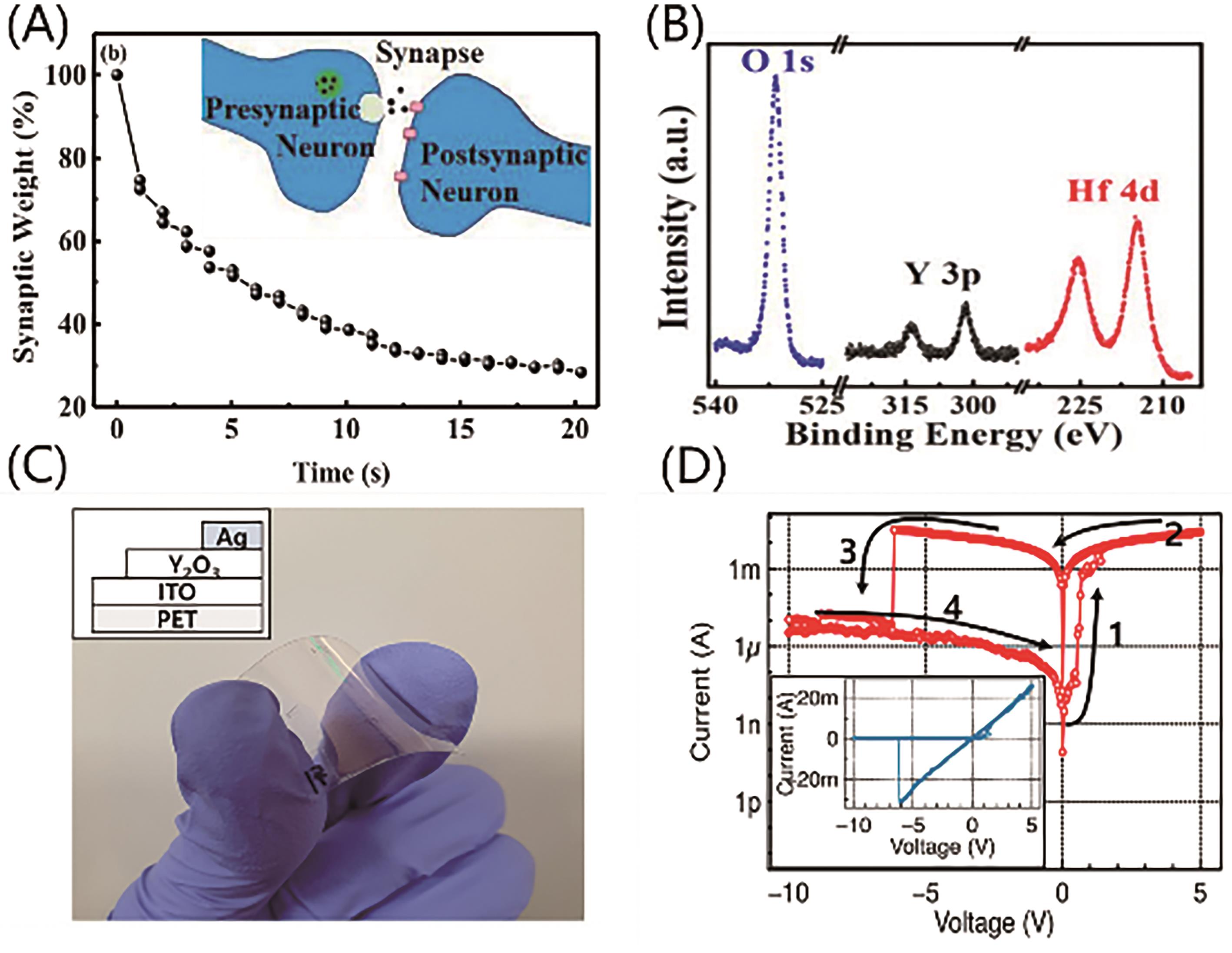
Fig.9 (A) The relaxation process of STP with respect to time and this is analogous to human-memory “forgetting process”, inset shows a schematic illustration of synapses[41]; (B) Normalized O1s, Y3p and Hf4d XPS spectra for the YDH thin film[42]; (C) Optical image of a fabricated flexible ITO/Y2O3/Ag RRAM device, inset shows a schematic of the fabricated devices[43]; (D) Representative I-V curve in the log scale, inset shows an I-V curve in the linear scale[43]
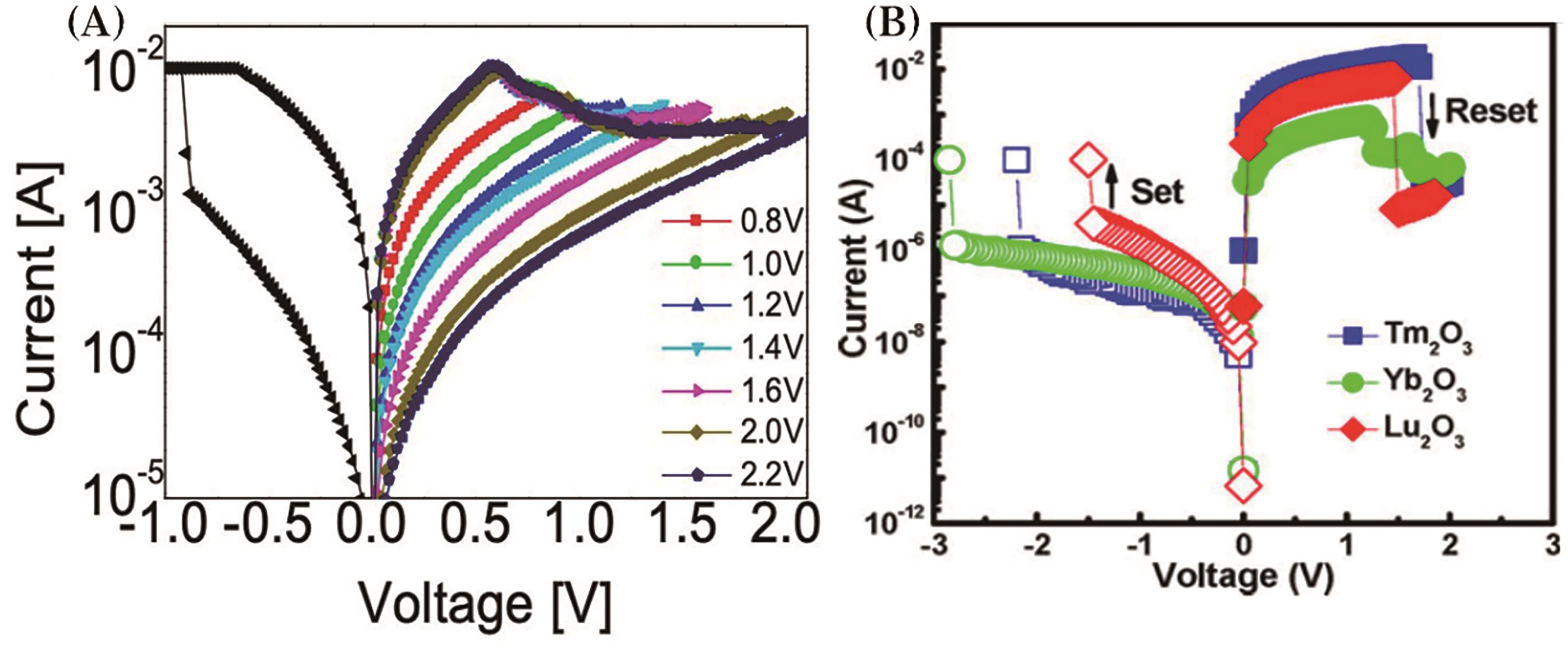
Fig.10 (A) I-V hysteresis loops of post-annealed devices for difference voltage and current conditions[48]; (B) I-V curves of resistive switching behavior in the Ru/RE2O3/TaN RRAM devices using Tm2O3,Yb2O3 and Lu2O3 thin films[49]
| Structure | Ron/Roff | VSET/V | VRESET/V | Endurance performance | Retention capability | Mechanism | Ref. |
|---|---|---|---|---|---|---|---|
| Pt/LaFeO3/LaAlO3(100)/LaNiO3 | 1×102 | -4 | +1 | >2×103 | — | VO-CFs | [ |
| Au/La0.5Pr0.5FeO3/Pt(111)/Ti/SiO2/Si/Au | 1 | +18 | +28.12 | — | — | Schottkybarrier | [ |
| Au/H-dopedNdNiO3/LaAlO3/Pt | ≈1×103 | ≈+0.06 | ≈-0.3 | >1.6×106 | — | — | [ |
| Au/BM-SCO/LSM/STO | 15.5 | +1~2 | +1~-2 | — | >3×102 | VO-CFs | [ |
| Au/BM-SCO/LSM/LAO | 3.5 | +1~2 | +1~-2 | — | >1×102 | VO-CFs | [ |
| Au/Zn-CeO2/Au | 105 | +2.25~0.75 | -1~-2 | 250 | — | VO-CFs | [ |
| Au/Ti/Ce1-x Y x O2-y /Pt | ≈1×103 | +0.5 | -1~-2 | 1×102 | 1 Year | VO-CFs | [ |
| Au/Ce0.9Y0.1O2/TiO2/Pt(1R1S) | 2.8×103 | +4~+8 | -4~-8 | — | — | Schottkybarrier | [ |
| Pt/HfO2∶CeO2/STO | 10~1×102 | 0~-1 | -4~-6 | — | — | VO-CFs | [ |
| Ag/CeO2/Pt | ≈4.3 | <+0.2 | <-0.4 | 1×102 | >5×104 s | Ag-CFs | [ |
| Pt/CeO2/Pt | 10 | <+1 | <-1 | >30 | >4.8×103 s | Schottkybarrier | [ |
| Pt/Ti-EL/Dy2O3/Pt | 1×106 | +0.54 | +0.2 | 1×103 | >1×106 s | VO-CFs | [ |
| Cu/Pt-nc/Dy2O3/Pt | 1×104 | +1.2 | +0.42 | 1×103 | >1×105 s, | VO-CFs | [ |
| Pt/DyMn2O5/TiN | 1×102 | +1~+2 | -1~-2 | 1×102 | >1×104 s | VO-CFs | [ |
| Ag/Er2O3/ITO | 7 | +1.95 | -3.63 | >250 | >2×104 s | VO-CFs | [ |
| Pt/Gd2O3/Pt | 1×106~1×107 | ≈+0.6 | — | >60 | >10 Year | VO-CFs | [ |
| IrO x /GdO x /Al2O3/TiN | 7 | +1.65/-2.43 | +3/-3.6 | >1×103 | — | VO-CFs | [ |
| TiN/Hf/Gd-O/TiN | >1×103 | <+2 | <+2 | 1×109 | >1×1010 s | — | [ |
| Au/Pr-CeO2/FTO | ≈2×103 | +0.5 | — | 1×103 | — | VO-CFs | [ |
| Pt/PCMO/TiN | — | -1.25 | +1.3 | — | — | [ | |
| Ni/Sm2O3/ITO | >1×103 | <+0.3 | <+0.7 | >1×104 | >1×105 s | Schottkybarrier | [ |
| Pt/YMn1-δ O3/Pt | 1×105 | +2.2~+10 | +0.6~+1.3 | 10 | >1×105 s | VO-CFs | [ |
| Pt/YCrO3(YCO)/Pt | 1×105 | +3.5 | +0.8 | 1×102 | 1×103 s | VO-CFs | [ |
| TiN/Y2O3/Pt | 1×102 | -1 | +0.97 | 8×102 | >1×108 | — | [ |
| n-Si/Y2O3/Al | ≈3~5 | +2~+4 | -2~-4 | >7×103 | 1×103 | Schottkybarrier | [ |
| AL/Y2O3/GZO/Y2O3/SI | ≈10 | +3 | -3 | — | — | VO-CFs | [ |
| ITO/Y2O3/Ag | 1×104~1×105 | <+2.5 | >-5 | 1.8×105 | 1×104 s | CFs | [ |
| GZO/Y2O3/Al | 2×102 | +1.8 | -1.93 | 7×105 | 1.5×105 s | — | [ |
| Au/Zr/YSZ/TiN/Ti | ≈1×104 | ±0.7 | ±1.1 | 1×103 | — | CFs | [ |
| TiN/CeO x /ZnO/ITO/Mica | — | — | — | — | — | CFs | [ |
| Ag/CeO2/SiO2/Pt | ≈1× | +0.08~+0.34 | >1×103 | — | [ |
Table 1 Summary of rare earth based memristor
| Structure | Ron/Roff | VSET/V | VRESET/V | Endurance performance | Retention capability | Mechanism | Ref. |
|---|---|---|---|---|---|---|---|
| Pt/LaFeO3/LaAlO3(100)/LaNiO3 | 1×102 | -4 | +1 | >2×103 | — | VO-CFs | [ |
| Au/La0.5Pr0.5FeO3/Pt(111)/Ti/SiO2/Si/Au | 1 | +18 | +28.12 | — | — | Schottkybarrier | [ |
| Au/H-dopedNdNiO3/LaAlO3/Pt | ≈1×103 | ≈+0.06 | ≈-0.3 | >1.6×106 | — | — | [ |
| Au/BM-SCO/LSM/STO | 15.5 | +1~2 | +1~-2 | — | >3×102 | VO-CFs | [ |
| Au/BM-SCO/LSM/LAO | 3.5 | +1~2 | +1~-2 | — | >1×102 | VO-CFs | [ |
| Au/Zn-CeO2/Au | 105 | +2.25~0.75 | -1~-2 | 250 | — | VO-CFs | [ |
| Au/Ti/Ce1-x Y x O2-y /Pt | ≈1×103 | +0.5 | -1~-2 | 1×102 | 1 Year | VO-CFs | [ |
| Au/Ce0.9Y0.1O2/TiO2/Pt(1R1S) | 2.8×103 | +4~+8 | -4~-8 | — | — | Schottkybarrier | [ |
| Pt/HfO2∶CeO2/STO | 10~1×102 | 0~-1 | -4~-6 | — | — | VO-CFs | [ |
| Ag/CeO2/Pt | ≈4.3 | <+0.2 | <-0.4 | 1×102 | >5×104 s | Ag-CFs | [ |
| Pt/CeO2/Pt | 10 | <+1 | <-1 | >30 | >4.8×103 s | Schottkybarrier | [ |
| Pt/Ti-EL/Dy2O3/Pt | 1×106 | +0.54 | +0.2 | 1×103 | >1×106 s | VO-CFs | [ |
| Cu/Pt-nc/Dy2O3/Pt | 1×104 | +1.2 | +0.42 | 1×103 | >1×105 s, | VO-CFs | [ |
| Pt/DyMn2O5/TiN | 1×102 | +1~+2 | -1~-2 | 1×102 | >1×104 s | VO-CFs | [ |
| Ag/Er2O3/ITO | 7 | +1.95 | -3.63 | >250 | >2×104 s | VO-CFs | [ |
| Pt/Gd2O3/Pt | 1×106~1×107 | ≈+0.6 | — | >60 | >10 Year | VO-CFs | [ |
| IrO x /GdO x /Al2O3/TiN | 7 | +1.65/-2.43 | +3/-3.6 | >1×103 | — | VO-CFs | [ |
| TiN/Hf/Gd-O/TiN | >1×103 | <+2 | <+2 | 1×109 | >1×1010 s | — | [ |
| Au/Pr-CeO2/FTO | ≈2×103 | +0.5 | — | 1×103 | — | VO-CFs | [ |
| Pt/PCMO/TiN | — | -1.25 | +1.3 | — | — | [ | |
| Ni/Sm2O3/ITO | >1×103 | <+0.3 | <+0.7 | >1×104 | >1×105 s | Schottkybarrier | [ |
| Pt/YMn1-δ O3/Pt | 1×105 | +2.2~+10 | +0.6~+1.3 | 10 | >1×105 s | VO-CFs | [ |
| Pt/YCrO3(YCO)/Pt | 1×105 | +3.5 | +0.8 | 1×102 | 1×103 s | VO-CFs | [ |
| TiN/Y2O3/Pt | 1×102 | -1 | +0.97 | 8×102 | >1×108 | — | [ |
| n-Si/Y2O3/Al | ≈3~5 | +2~+4 | -2~-4 | >7×103 | 1×103 | Schottkybarrier | [ |
| AL/Y2O3/GZO/Y2O3/SI | ≈10 | +3 | -3 | — | — | VO-CFs | [ |
| ITO/Y2O3/Ag | 1×104~1×105 | <+2.5 | >-5 | 1.8×105 | 1×104 s | CFs | [ |
| GZO/Y2O3/Al | 2×102 | +1.8 | -1.93 | 7×105 | 1.5×105 s | — | [ |
| Au/Zr/YSZ/TiN/Ti | ≈1×104 | ±0.7 | ±1.1 | 1×103 | — | CFs | [ |
| TiN/CeO x /ZnO/ITO/Mica | — | — | — | — | — | CFs | [ |
| Ag/CeO2/SiO2/Pt | ≈1× | +0.08~+0.34 | >1×103 | — | [ |
| 1 | CHUA L. Memristor-the missing circuit element[J]. IEEE Trans Circuit Theory, 1971, 18(5): 507-519. |
| 2 | STRUKOV D B, SNIDER G S, STEWART D R, et al. The missing memristor found[J]. Nature, 2008, 453(7191): 80-83. |
| 3 | 刘东青, 程海峰, 朱玄, 等. 忆阻器及其阻变机理研究进展[J]. 物理学报, 2014, 63(18): 187301. |
| LIU D Q, CHENG H F, ZHU X, et al. Research progress of memristors and memristive mechanism[J]. Acta Phys Sin, 2014, 63(18): 187301. | |
| 4 | PRAKASH A, JANA D, MAIKAP S. TaOx-based resistive switching memories: prospective and challenges[J]. Nanoscale Res Lett, 2013, 8(1): 1-17. |
| 5 | BIOLEK D, BIOLEK Z, BIOLKOVA V. Pinched hysteretic loops of ideal memristors, memcapacitors and meminductors must be ‘self-crossing’[J]. Electronics Lett, 2011, 47(25): 1385-1387. |
| 6 | HSU C H, FAN Y S, LIU P T. Multilevel resistive switching memory with amorphous InGaZnO-based thin film[J]. Appl Phys Lett, 2013, 102(6): 062905. |
| 7 | 张颖, 龙世兵, 刘明. 新型阻变存储器的物理研究与产业化前景[J]. 物理, 2017, 46(10): 645-657. |
| ZHANG Y, LONG S B,LIU M. The physics and industrialization prospects of RRAMs[J]. Physics, 2017, 46(10): 645-657. | |
| 8 | HUANG C H, HUANG J S, LIN S M, et al. ZnO1- x nanorod arrays/ZnO thin film bilayer structure: from homojunction diode and high-performance memristor to complementary 1D1R application[J]. ACS Nano, 2012, 6(9): 8407-8414. |
| 9 | KIM K M, LEE S R, KIM S, et al. Self-limited switching in Ta2O5/TaOx memristors exhibiting uniform multilevel changes in resistance[J]. Adv Funct Mater, 2015, 25(10): 1527-1534. |
| 10 | CHOI B J, TORREZAN A C, NORRIS K J, et al. Electrical performance and scalability of Pt dispersed SiO2 nanometallic resistance switch[J]. Nano Lett, 2013, 13(7): 3213-3217. |
| 11 | XIA Q, ROBINETT W, CUMBIE M W, et al. Memristor-CMOS hybrid integrated circuits for reconfigurable logic[J]. Nano Lett, 2009, 9(10): 3640-3645. |
| 12 | HUANG X, ZHANG G, PAN A, et al. Protecting the environment and public health from rare earth mining[J]. Earths Future, 2016, 4(11): 532-535. |
| 13 | LUO X, ZHANG Y, ZHOU H, et al. Review on the development and utilization of ionic rare earth ore[J]. Minerals, 2022, 12(5): 554. |
| 14 | ZHANG B, SONG Z, JIN J, et al. Efficient rare earth Co-doped TiO2 electron transport layer for high-performance perovskite solar cells[J]. J Colloid Interfaces Sci, 2019, 553: 14-21. |
| 15 | DAS M, KUMAR A, MANDAL B, et al. Impact of Schottky junctions in the transformation of switching modes in amorphous Y2O3-based memristive system[J]. J Phys D Appl Phys, 2018, 51(31): 315102. |
| 16 | ZHOU Q, ZHAI J. Study of the resistive switching characteristics and mechanisms of Pt/CeOx/TiN structure for RRAM applications[J]. Integr Ferroelectr, 2012, 140(1): 16-22. |
| 17 | MENZEL S. Comprehensive modeling of electrochemical metallization memory cells[J]. J Comput Electron, 2017, 16(4): 1017-1037. |
| 18 | CHEN K H, KAO M C, HUANG S J, et al. Bipolar switching properties of neodymium oxide RRAM devices using by a low temperature improvement method[J]. Materials, 2017, 10(12): 1415. |
| 19 | MOHAMMAD B, JAOUDE M A, KUMAR V, et al. State of the art of metal oxide memristor devices[J]. Nanotechnol Rev, 2016, 5(3): 311-329. |
| 20 | KAMIYA K, YANG M Y, PARK S G, et al. ON-OFF switching mechanism of resistive-random-access-memories based on the formation and disruption of oxygen vacancy conducting channels[J]. Appl Phys Lett, 2012, 100(7): 073502. |
| 21 | PAN F, GAO S, CHEN C, et al. Recent progress in resistive random access memories: materials, switching mechanisms, and performance[J]. Mat Sci Eng R, 2014, 83: 1-59. |
| 22 | 王玮, 陈晋, 余林峰, 等. 两类阻变机理及性能改善方法的研究[J]. 中国电子学报, 2017, 45(4): 989. |
| WANG W, CHEN J, YU L F, et al. A research of two kind of mechanism and performance improvement of resistive switching access memory[J]. Chin J Electron, 2017, 45(4): 989. | |
| 23 | 秦瑞东, 陈玲丽, 朱宇波, 等. 忆阻器及其在人工突触器件中的研究进展[J]. 功能材料与器件学报, 2021, 27(6): 494-504. |
| QIN R D, CHEN L L, ZHU Y B, et al. Research progress of memristor and its application in artificial synaptic devices[J]. J Funct Mater Dev, 2021, 27(6): 494-504. | |
| 24 | DIRKMANN S, HANSEN M, ZIEGLER M, et al. The role of ion transport phenomena in memristive double barrier devices[J]. Sci Rep-UK, 2016, 6(1): 1-12. |
| 25 | 贾林楠, 黄安平, 郑晓虎, 等. 界面效应调制忆阻器研究进展[J]. 物理学报, 2012, 61(21): 432-442. |
| JIA L N, HUANG A P, ZHENG X H, et al. Progress of memristor modulated by interfacial effect[J]. Acta Phys Sin, 2012, 61(21): 432-442. | |
| 26 | WU M L, YANG C P, SHI D W, et al. Electric-pulse-induced resistance switching effect in the bulk of La0.5Ca0.5MnO3 ceramics[J]. Aip Adv, 2014, 4(4): 047123. |
| 27 | KANG W, WOO K, NA H B, et al. Analog memristive characteristics of square shaped lanthanum oxide nanoplates layered device[J]. Nanomaterials, 2021, 11(2): 441. |
| 28 | HU Q, KANG T S, ABBAS H, et al. Resistive switching characteristics of Ag/MnO/CeO2/Pt heterostructures memory devices[J]. Microelectron Eng, 2018, 189: 28-32. |
| 29 | HU Q, KANG T S, ABBAS H, et al. Forming-free resistive switching characteristics of manganese oxide and cerium oxide bilayers with crossbar array structure[J]. Jpn J Appl Phys, 2018, 57(8): 086501. |
| 30 | YOUNIS A, CHU D, LIN X, et al. High-performance nanocomposite based memristor with controlled quantum dots as charge traps[J]. ACS Appl Mater Interfaces, 2013, 5(6): 2249-2254. |
| 31 | CHO S, YUN C, TAPPERTZHOFEN S, et al. Self-assembled oxide films with tailored nanoscale ionic and electronic channels for controlled resistive switching[J]. Nat Commun, 2016, 7(1): 12373. |
| 32 | KIM H J, ZHENG H, PARK J S, et al. Artificial synaptic characteristics with strong analog memristive switching in a Pt/CeO2/Pt structure[J]. Nanotechnology, 2017, 28(28): 285203. |
| 33 | KIM H J, PARK D, YANG P, et al. Synaptic characteristics with strong analog potentiation, depression, and short-term to long-term memory transition in a Pt/CeO2/Pt crossbar array structure[J]. Nanotechnology, 2018, 29(26): 265204. |
| 34 | KIM H J, KIM M, BEOM K, et al. A Pt/ITO/CeO2/Pt memristor with an analog, linear, symmetric, and long-term stable synaptic weight modulation[J]. APL Mater, 2019, 7(7): 071113. |
| 35 | SONG L W, NIU S S, SUN Y C, et al. Crystallinity dependence of resistive switching in Ti/Pr(Sr0.1Ca0.9)2Mn2O7/Pt: filamentary versus interfacial mechanisms[J]. Appl Phys Lett, 2014, 104(9): 093502. |
| 36 | HE S, HAO A, QIN N, et al. Unipolar resistive switching properties of Pr-doped ZnO thin films[J]. Ceram Int, 2017, 43: S474-S480. |
| 37 | KUKLI K, AARIK L, VINUESA G, et al. Structure and electrical behavior of hafnium-praseodymium oxide thin films grown by atomic layer deposition[J]. Materials, 2022, 15(3): 877. |
| 38 | KOSSAR S, AMIRUDDIN R, RASOOL A, et al. Study on ferroelectric polarization induced resistive switching characteristics of neodymium-doped bismuth ferrite thin films for random access memory applications[J]. Curr Appl Phys, 2022, 39: 221-229. |
| 39 | HUANG S Y, CHANG T C, CHEN M C, et al. Resistive switching characteristics of Sm2O3 thin films for nonvolatile memory applications[J]. Solid-State Electron, 2011, 63(1): 189-191. |
| 40 | SHARMA Y, MISRA P, PAVUNNY S P, et al. Multilevel unipolar resistive memory switching in amorphous SmGdO3 thin film[J]. Appl Phys Lett, 2014, 104(7): 073501. |
| 41 | DAS M, KUMAR A, SINGH R, et al. Realization of synaptic learning and memory functions in Y2O3 based memristive device fabricated by dual ion beam sputtering[J]. Nanotechnology, 2018, 29(5): 055203. |
| 42 | WANG Y, NIU G, WANG Q, et al. Reliable resistive switching of epitaxial single crystalline cubic Y-HfO2 RRAMs with Si as bottom electrodes[J]. Nanotechnology, 2020, 31(20): 205203. |
| 43 | KIM H J, KIM D W, LEE W Y, et al. Flexible sol-gel-processed Y2O3 RRAM devices obtained via UV/ozone-assisted photochemical annealing process[J]. Materials, 2022, 15(5): 1899. |
| 44 | HER J L, PAN T M, LU C H. Unipolar resistive switching behavior in Dy2O3 films for nonvolatile memory applications[J]. Thin Solid Films, 2012, 520(17): 5706-5709. |
| 45 | ZHAO H, TU H, WEI F, et al. Highly transparent dysprosium oxide-based RRAM with multilayer graphene electrode for low-power nonvolatile memory application[J]. IEEE Trans Electron Dev, 2014, 61(5): 1388-1393. |
| 46 | PANIGRAHY S, DHAR J C. Non-volatile memory application of glancing angle deposition synthesized Er2O3 capped SnO2 nanostructures[J]. Semicond Sci Tech, 2020, 35(5): 055035. |
| 47 | JANA D, DUTTA M, SAMANTA S, et al. RRAM characteristics using a new Cr/GdOx/TiN structure[J]. Nanoscale Res Lett, 2014, 9: 1-9. |
| 48 | YUN H J, RYU S Y, LEE H Y, et al. Multilevel operation of GdOx-based resistive switching memory device fabricated by post-deposition annealing[J]. Ceram Int, 2021, 47(12): 16597-16602. |
| 49 | PAN T M, LU C H, MONDAL S, et al. Resistive switching characteristics of Tm2O3, Yb2O3, and Lu2O3-based metal-insulator-metal memory devices[J]. IEEE Trans Nanotechnol, 2012, 11(5): 1040-1046. |
| 50 | FU Y J, XIA F J, JIA Y L, et al. Bipolar resistive switching behavior of La0.5Sr0.5CoO3- σ films for nonvolatile memory applications[J]. Appl Phys Lett, 2014, 104(22): 223505. |
| 51 | GADANI K, RATHOD K N, DHRUV D, et al. Defects induced resistive switching behavior in Ca doped YMnO3-based non-volatile memory devices through electronic excitations[J]. Mat Sci Semicon Proc, 2021, 121: 105347. |
| 52 | SCHMITT R, KUBICEK M, SEDIVA E, et al. Accelerated ionic motion in amorphous memristor oxides for nonvolatile memories and neuromorphic computing[J]. Adv Funct Mater, 2018: 1804782. |
| 53 | RANIERI M G A, ORTEGA P P, MORENO H, et al. Resistive switching and multiferroic behavior of La0.5Pr0.5FeO3 ferrite thin films[J]. J Alloys Compd, 2020, 851: 156936. |
| 54 | ZHANG H T, PARK T J, ISLAM A N M N, et al. Reconfigurable perovskite nickelate electronics for artificial intelligence[J].Science, 2022, 375(6580): 533-539. |
| 55 | XIANG X, RAO J, LIM C, et al. Manipulating the resistive switching in epitaxial SrCoO2.5 thin-film-based memristors by strain engineering[J]. ACS Appl Electron Mater, 2022, 4(6): 2729-2738. |
| 56 | REHMAN S, KIM H, FAROOQ Khan M, et al. Tuning of ionic mobility to improve the resistive switching behavior of Zn-doped CeO2[J]. Sci Rep-UK, 2019, 9(1): 19387. |
| 57 | KIM S M, MOON H G, LEE H S. Resistive switching characteristics of directly patterned Y-doped CeO2 by photochemical organic-metal deposition[J]. Ceram Int, 2020, 46(14): 22831-22836. |
| 58 | KIM S E, LEE J G, CHOI I Y, et al. Resistive switching characteristic of Ce0.9Y0.1O2/TiO2 bi-layer structure by photochemical metal-organic deposition[J]. J Korean Ceram Soc, 2020, 57: 73-79. |
| 59 | DOU H, GAO X, ZHANG D, et al. Electroforming-free HfO2∶CeO2 vertically aligned nanocomposite memristors with anisotropic dielectric response[J]. ACS Appl Electron Mater, 2021, 3(12): 5278-5286. |
| 60 | LI H, LIU T, WANG Y, et al. Electronic synaptic characteristics and simulation application of Ag/CeO2/Pt memristor[J]. Ceram Int, 2022, 48(10): 13754-13760. |
| 61 | PARK K, CHUNG P H, SAHU D P, et al. Interface state-dependent synaptic characteristics of Pt/CeO2/Pt memristors controlled by post-deposition annealing[J]. Mater Sci Semicon Proc, 2022, 147: 106718. |
| 62 | ZHAO H, TU H, WEI F, et al. The enhancement of unipolar resistive switching behavior via an amorphous TiOx layer formation in Dy2O3-based forming-free RRAM[J]. Solid State Electron, 2013, 89: 12-16. |
| 63 | ZHAO H B, TU H L, WEI F, et al. Resistive switching characteristics of Dy2O3 film with a Pt nanocrystal embedding layer formed by pulsed laser deposition[J]. Rare Met, 2014, 33: 75-79. |
| 64 | TSAI Y T, CHANG T C, HUANG W L, et al. Investigation for coexistence of dual resistive switching characteristics in DyMn2O5 memory devices[J]. Appl Phys Lett, 2011, 99(9): 092106. |
| 65 | MAO S, ZHOU G, SUN B, et al. Mechanism analysis of switching direction transformation in an Er2O3 based RRAM device[J]. Curr Appl Phys, 2019, 19(12): 1421-1426. |
| 66 | PAN T M, LU C H. Forming-free resistive switching behavior in Nd2O3, Dy2O3, and Er2O3 films fabricated in full room temperature[J]. Appl Phys Lett, 2011, 99(11): 113509. |
| 67 | JANA D, SAMANTA S, MAIKAP S, et al. Evolution of complementary resistive switching characteristics using IrOx/GdOx/Al2O3/TiN structure[J]. Appl Phys Lett, 2016, 108(1): 011605. |
| 68 | CHEN C Y, GOUX L, FANTINI A, et al. Doped Gd-O based RRAM for embedded application[C]. In 2016 IEEE 8th International Memory Workshop (IMW). IEEE, 2016: 1-4. |
| 69 | CHEN N, LI S. Synthesis of oxygen-deficient and monodispersed Pr doped CeO2 nanocubes with enhanced resistive switching properties[C]. IOP Conference Series: Materials Science and Engineering. IOP Publishing, 2019, 576(1): 012035. |
| 70 | PYO Y, NAHM S, JEONG J, et al. Implementation of hardware-based neural network using memristors with abrupt SET and gradual RESET characteristics[C]. 2020 8th International Winter Conference on Brain-Computer Interface (BCI). IEEE, 2020: 1-3. |
| 71 | MONDAL S, CHUEH C H, PAN T M. High-performance flexible Ni/Sm2O3/ITO ReRAM device for low-power nonvolatile memory applications[J]. IEEE Electr Device L, 2013, 34: 1145-1147. |
| 72 | YAN J, CHENG H C, GAUZA S, et al. Extended Kerr effect of polymer-stabilized blue-phase liquid crystals[J]. Appl Phys Lett, 2010, 96(7): 071105. |
| 73 | SHARMA Y, MISRA P, KATIYAR R S. Unipolar resistive switching behavior of amorphous YCrO3 films for nonvolatile memory applications[J]. J Appl Phys, 2014, 116(8): 084505. |
| 74 | PETZOLD S, PIROS E, SHARATH S U, et al. Gradual reset and set characteristics in yttrium oxide based resistive random access memory[J]. Semicond Sci Tech, 2019, 34(7): 075008. |
| 75 | MANDAL B, SIDDHARTH G, MUKHERJEE S. Impact of interfacial SiO2 on dual ion beam sputtered Y2O3-based memristive system[J]. IEEE Trans Nanotechnol, 2020, 19: 332-337. |
| 76 | GAUTAM M K, KUMAR S, MUKHERJEE S. Y2O3-based memristive crossbar array for synaptic learning[J]. J Phys D Phys, 2022, 55(20): 205103. |
| 77 | KIM D W, KIM H J, LEE W Y, et al. Enhanced switching reliability of sol-gel-processed Y2O3 RRAM devices based on Y2O3 surface roughness-induced local electric field[J]. Materials, 2022, 15(5): 1943. |
| 78 | KUMAR S, DAS M, HTAY M T, et al. Electroforming-free Y2O3 memristive crossbar array with low variability[J]. ACS Appl Electron Mater, 2022, 4(6): 3080-3087. |
| 79 | KUMAR S, GAUTAM M K, GILL G S, et al. 3-D physical electro-thermal modeling of nanoscale Y2O3 memristors for synaptic application[J]. IEEE Trans Electron Dev, 2022, 69(6): 3124-3129. |
| 80 | ZHOU Z, PEI Y, ZHAO J, et al. Visible light responsive optoelectronic memristor device based on CeOx/ZnO structure for artificial vision system[J]. Appl Phys Lett, 2021, 118(19): 191103. |
| 81 | SAHU D P, PARK K, HAN J, et al. Improvement of forming-free threshold switching reliability of CeO2-based selector device by controlling volatile filament formation behaviors[J]. Appl Mater, 2022, 10(5): 051111. |
| 82 | CHIEN C S, TSAI M H, HUANG C L. Electrical properties and current conduction mechanisms of LaGdO3 thin film by RF sputtering for RRAM applications[J]. J Asian Ceram Soc, 2020, 8(3): 948-956. |
| [1] | Yi-Cheng ZHANG, Fei ZHA, Xiao-Hua TANG, Yue CHANG, Hai-Feng TIAN, Xiao-Jun GUO. Research Progress of Heterogeneous Catalytic Preparation of Organic Peroxides [J]. Chinese Journal of Applied Chemistry, 2023, 40(6): 769-788. |
| [2] | Yi-Chen YU, Yu-Chen ZHANG, Yao-Yuan ZHANG, Qin WU, Da-Xin SHI, Kang-Cheng CHEN, Han-Sheng LI. Research Progress of Bulk Metal Oxides for Non-oxidative Propane Dehydrogenation [J]. Chinese Journal of Applied Chemistry, 2023, 40(6): 789-805. |
| [3] | Wen-Jun SHI, Zhong-Hui SUN, Zhong-Qian SONG, XU-Jia NAN, Dong-Xue HAN, Li NIU. Research Progress of Layered Transition Metal Oxides Cathode Materials for Sodium-ion Batteries [J]. Chinese Journal of Applied Chemistry, 2023, 40(4): 583-596. |
| [4] | Peng BU, Hong-Liang LI. Preparation and Upconversion Luminescence Study of Rare Earth Yb3+/Tm3+ Doped NaGd(MO4)2 Phosphors [J]. Chinese Journal of Applied Chemistry, 2023, 40(3): 374-379. |
| [5] | Yu-Xuan PENG, Xiao WANG, Hong-Yan JI, Xue-Ting WU, Shu-Yan SONG, Hong-Jie ZHANG. Enhancing Catalytic Activity of Ru/CeO2 in Terephthalic Acid Hydro-Conversion via Reduction Pre-Treatment of CeO2 Support [J]. Chinese Journal of Applied Chemistry, 2023, 40(11): 1494-1503. |
| [6] | Lin-Feng WANG, Hui TIAN, Guang-Bi GONG, Chun-Ji WU, Bao-Li WANG, Dong-Mei CUI. Terpolymerization of Ethylene, Cyclic Olefin and 1-Octene Catalyzed by Rare Earth Complexes [J]. Chinese Journal of Applied Chemistry, 2023, 40(10): 1396-1404. |
| [7] | Qi ZHANG, Qian ZHANG, Xiao-Meng SHI, Ya-Qi KONG, Ke-Xin GAO, Ya-Ping DU. Research Progress of Rare Earth Bromides Based Solid Electrolytes for All⁃Solid⁃State Batteries [J]. Chinese Journal of Applied Chemistry, 2022, 39(4): 585-598. |
| [8] | Song-Tao ZHANG, Ying-Hui WANG, Hong-Jie ZHANG. Nd3+ Sensitized Fluorescent Nanoprobes for Vascular Imaging in the Second Near Infrared Window [J]. Chinese Journal of Applied Chemistry, 2022, 39(4): 685-693. |
| [9] | MA Pingchuan, MA Lili, YANG Zhenghui, GUO Haiquan, GAO Lianxun. Improved Corona-Resistance Properties of Alumina/Polyimide Films with Exfoliated Layered Double Hydroxide Nanosheets [J]. Chinese Journal of Applied Chemistry, 2020, 37(6): 666-672. |
| [10] | HU Jiale, XUE Dongfeng. Research Progress on the Characteristics of Rare Earth Ions and Rare Earth Functional Materials [J]. Chinese Journal of Applied Chemistry, 2020, 37(3): 245-255. |
| [11] | HAO Bin,ZHAO Wenwu,YU Jianyuan,LIU Jinqiang,LIU Jian,DONG Xiuzhen,WANG Xiuwen. Preparation and Luminescence Property of Ba5-3x/2B4O11∶xEu3+ Phosphor [J]. Chinese Journal of Applied Chemistry, 2019, 36(5): 548-553. |
| [12] | LIU Ning,LIU Shuilin,WU Suyun,TANG Xinde,WU Zhi,LI Aiyang. CTAB-P123-Assisted Synthesis of Orderly Mesoporous KF/Al-Ce-SBA-15 Solid Base and Its Catalytic Application [J]. Chinese Journal of Applied Chemistry, 2019, 36(11): 1294-1300. |
| [13] | LI Fei,XIA Zhiguo. Rare Earth Doped Phosphors and Inorganic Quantum Dots for Solid State Lighting:Opportunity and Challenge [J]. Chinese Journal of Applied Chemistry, 2018, 35(8): 859-870. |
| [14] | LONG Xia,WANG Yaqiong,JU Min,WANG Zheng,YANG Shihe. Elaboration and Application of Transition Metals Based Layered Double Hydroxides for Electrochemical Water Oxidation [J]. Chinese Journal of Applied Chemistry, 2018, 35(8): 881-889. |
| [15] | Lei YANG, Yunxing ZHANG, Xiaoqin WANG. Preparation and Release Behavior of Ibuprofen Intercalated Hydrotalcite/Starch Gel Composites [J]. Chinese Journal of Applied Chemistry, 2018, 35(7): 781-787. |
| Viewed | ||||||
|
Full text |
|
|||||
|
Abstract |
|
|||||
